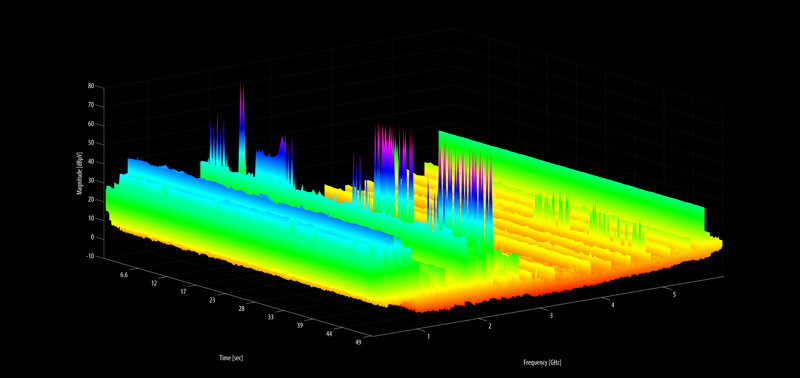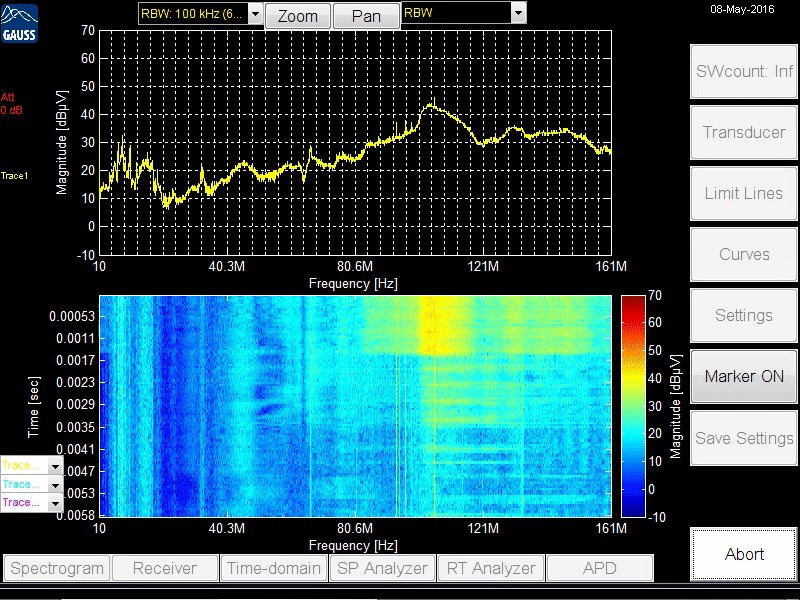Emissions measurements of the electrical field strength in the frequency range of 1 GHz to 40 GHz are carried out in an anechoic chamber or at an open area test site. Usually these measurements are very time-consuming as the maximum radiation has to be found over all angular positions of the device under test (DUT) as well as over all antenna heights. DUTs with highly directive radiation characteristics above 1 GHz require very small angular steps of the turntable for getting the accurate position of the maximum emission, making the testing procedure even more time-consuming.

In the past, therefore a pre- and final scan test procedure has been performed usually trying to reduce the overall test time. During the pre-scan procedure, which is just a quick overview measurement by the way, the critical frequencies with maximum emissions are going to be detected. After detecting these critical frequencies the final measurement is carried out in the single frequency mode with longer dwell times now to achieve a more accurate result.
Now, GAUSS INSTRUMENTS introduced a novel real-time scanning feature for their TDEMI X test receiver series providing several gigahertz real-time bandwidth (Option QCDSP-UG, UFSPA-UG) and thus the final maximization can be performed at all frequencies simultaneously in just one step. Due to the newly designed powerful hardware module, such measurements over several gigahertzs can be performed in the real-time spectrum analyzer mode. E. g., in the frequency range from 1 GHz to 6 GHz all frequency points can be directly measured with a very high resolution in time and the result can be maximized instantaneously. Over the whole frequency range the results are shown in real-time. The detectors peak, average and RMS are available in this mode. Further the video bandwidths, which are required according to the standards, can be applied. Of course all the measurements according to the standards CISPR 16-1-1, MIL461, DO160 as well as further national and international standards are fully covered.
For the very first time, a typical emission measurement in the range of 1 GHz up to 6 GHz the full frequency range is scanned in real-time now by testing with the TDEMI X test receiver of GAUSS INSTRUMENTS. The DUT is rotated in just one continuous move and the direction as well as the maximum level of emission is recorded. All the requirements of the standards CISPR 16-2-3 as well as the ANSI and FCC standards are fulfilled by the TDEMI X receiver.
Thus, challenging measurement tasks, for example the measurement of microwave ovens, can be performed in a very fast and efficient way, and easy to do for the operator. The pre-selection, which is applicable over the entire frequency range of DC – 40 GHz in all operation modes, e.g. in particular in the real-time measurement mode, allows for example the measuring of the signal harmonics of an ISM band with highest precision as well as dynamic. With the standard deviation which is typically 0.27 dB for the frequency range from 1 GHz up to 18 GHz, the TDEMI X is setting the benchmark also regarding the measurement accuracy of EMI test receivers.
All the operation modes of a DUT can be measured in a simple way and highly efficient. A former time-consuming pre- and final scan test strategy is past and no longer needed. Also the evaluation against the limit lines as well as the documentation of the measurements are performed fully automatic by the integrated report generator module and stored as MS-Word document. Bya remote control software it is also possible to fully automate such measurements including controlling turntable and antenna mast and to create test reports including radiation patterns of the DUT.

The video shows the real-time measurement of a broadband emission highly fluctuating. The measurement is performed in the real-time spectrum analyzer (RTSA) and a 6 dB resoltuion bandwidth (RBW) of 100 kHz and MaxPeak detector was applied. Especially very fast changing, highly fluctuating broadband emissions or intermittent disturbances can be captured in their full bandwidth and measured highly reliable. Without the need of any prior knowledge about the device under test or circuitry or its emissions, the measurement is carried out in real-time and the analysis becomes just a walk-over. At the same time the reliabilty is increased and the measurement is reduced significantly compared to conventional procedures like pre- and final scan approaches which are creating additional measurement uncertainty. Especially for testing and analyzing of todays complex circuitries and systems, providing a huge number of operation modes and different types of emissions, caused by the more and more digitalisation and smart functions, this becomes an absolutely crucial factor.